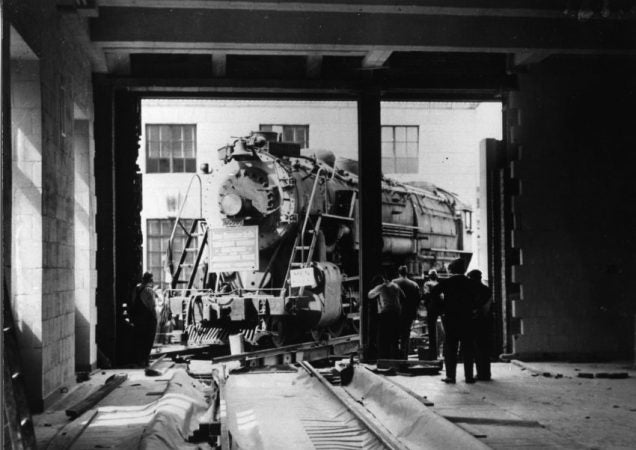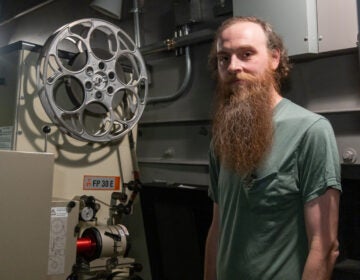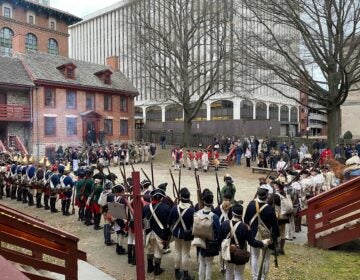The Franklin Institute will transform The Train Factory room into a showcase of historic invention
For some visitors who have enjoyed the Franklin Institute as kids and now as parents, the fact that there is a train exhibit featuring a 350-ton locomotive may be a surprise.
-

A redesign of the Franklin Institute's Train Factory exhibit will create new curatorial space and provide a glimpse into the curatorial process. (Courtesy of the Smith Group for the Franklin Institute)
-

The Baldwin locomotive donated by Baldwin Locomotive Works President, Samuel Vauclain was rolled into place in the Franklin Institute in 1933 and has remained there ever since. (Courtesy of the Franklin Institute)
-

The Baldwin locomotive donated by Baldwin Locomotive Works President, Samuel Vauclain was rolled into place in the Franklin Institute in 1933 and has remained there ever since. (Courtesy of the Franklin Institute)
-

Donald E. Morel, Jr., chairman of the board of trustees of the Franklin Institute, announces that a $6 million gift from the Hamilton Family Charitable Trust will transfrom the iconic Train Factory exhibit into a an open curatorial space. (Emma Lee/WHYY)
In 1933, a 350-ton locomotive engine steamed into the Franklin Institute on the Parkway in Philadelphia, a gift of the Baldwin Locomotive Works and its president, Samuel Vauclain.
It hasn’t moved since — 86 years later.
Vauclain wanted to put his massive Baldwin 60000 prototype on public display. It traveled from 24th and Vine streets, across the Parkway (it took five days to move it five blocks) and into an open shed at the Franklin Institute, which was still under construction at the time.
“The story goes that it was supposed to be a temporary loan,” said Vauclain’s great-grandson, Matthew Hamilton. “Then they walled it up and said, ‘Thank you for the gift.’”
No hard feelings: an exhibition about railroad technology was built around the Baldwin, including two other historic steam cars. The Train Factory room at the Franklin Institute prominently features a bust of Vauclain, who, as an engineer, invented a steam engine design called the Vauclain compound.
For some visitors who have enjoyed the Franklin Institute as kids and again as parents, the fact that there is a train exhibition featuring a real, 350-ton steam locomotive may come as a surprise. The exhibition is on the ground floor, just beyond the planetarium — off the beaten path of the Institute’s other attractions.
That’s all about to change. The Franklin Institute plans to transform the room into a showcase of the history of invention. Many of the railroad artifacts will be removed, a big part of the floor will be removed to expose the floor beneath, and objects from the Institute’s archive that have never been on public display before will be on view.
“We do want an institution that is more welcoming, that can show more,” said Larry Dubinski, the Institute’s president and CEO. “That’s how we’re going to transform the gallery. We’re going to make it a two-story gallery, make it more visitor-friendly, and I would say even more inspiring than it is now.”
The Hamilton Family Charitable Trust is backing the transformation with a $6 million gift, the largest gift the family foundation has ever given. Since Vauclain’s original heavy duty gift, four generations of his descendants have been generous supporters of the Franklin Institute.
Now the focus of the room will shift away from their ancestors’ passion. Once again, no hard feelings.
“My great-grandfather’s bust will always be there, and the family name, and the engine,” Matthew Hamilton said. “It will be great to add the opportunity for the Franklin to show their archival pieces, which are innovative. You never really think that everything from photography to electronics was happening at the turn of that century.”
The new exhibition will be called Treasures of the Franklin Institute. It has not yet determined what exactly will be in it. At an event announcing the plan, the Institute brought out some of its treasures, including a series of silver daguerreotypes representing a panoptic view of the Fairmount Water Works just as it was completed in the late 1800s. It will also include the first moving film projector, fixed to a piece of lumber; and scraps of wallpaper from the Wright Brothers bicycle shop, on the backs of which they scribbled aerodynamic wing diagrams.
The rebuild will also reveal an architectural detail long obscured. To bear the weight of the locomotive, the floor was designed with different kinds of trusses normally used on bridges. The original idea was to display varieties of railroad infrastructure architecture.
But over the years the level below the train turned into office spaces, and the trusses were eventually covered over. The new plans will once again reveal the iron undergirding.
The rebuild is expected to be completed by 2024.
Disclaimer: The Hamilton Family Foundation have been supporters of WHYY.
WHYY is your source for fact-based, in-depth journalism and information. As a nonprofit organization, we rely on financial support from readers like you. Please give today.










